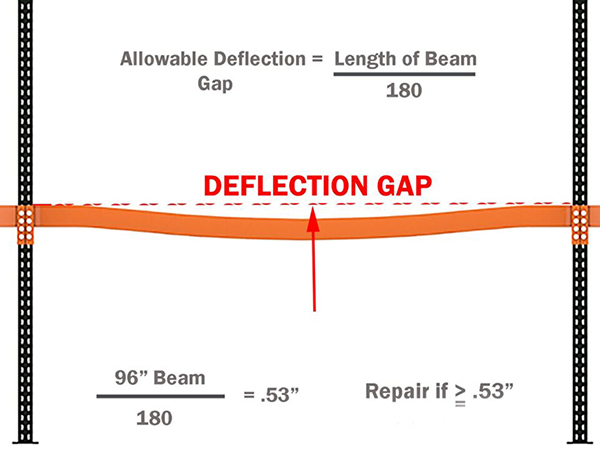When the Beam Deflection of a pallet rack pose a risk?
Generally,pallet rack Manufacturer‘s beam tables are based on uniformly distributed loads. Both the capacity and the beam deflection will vary if the load is not uniformly distributed on the load shelf beams. Small degree of deflection is normal for a loaded rack system, how to tell the reduction of a beam capacity when it have deflection?
Safe Tips:Any beam with visible deformation or cracking of the beam end connectors or welds should be unloaded and replaced. Be sure beams are fully engaged when installed and the safety locks are properly seated.
How to Determine if Beams are Overloaded
1. Observe the beam deflection
Reference Standard: LENGTH OF BEAM/180= ALLOWABLE DEFLECTION;
Example:96’’BEAM/180=0.53’’ ALLOWABLE DEFLECTION.
The maximum allowed deflection is the length of a beam divided by 180. Deflection of the beam greater than the length mean overload.Max deflection is located at the midpoint of a beam for uniformly distributed load.
However, this deflection limit is not in place to ensure the structural integrity of the beam or rack. Instead, it’s to ensure that personnel interacting with and working around the rack feel safe when they see normal pallet beam deflection. Racking system experts determined that the calculation length divided by 180 quantified the point at which persons believe the situation is unsafe when deflection in pallet rack is observed.
Some AS/RS or automated systems typically specify a tighter deflection limit for the load beams, safe deflection less than the length of a beam divided by 240 (or Multiplied by 0.42%). This tighter deflection requirement minimizes the risk of the automation (or the load) coming into contact with the beams during placement or removal.
When see a beam overloaded and has permanent deflection,you should unload the beam and replace it.
2. Check the connection at the frame
Inspect the area where the beam connects to the frame. If any of the following conditions are present, the beam should be replaced.
. There is any visual deformation of the column or the clips indicating that the beam was either damaged by impact or overload.
. There are any cracks in welded joints
. The safety clip cannot be properly connected and fully engaged.
While beam deflection itself has no bearing on the capacity or safety of your rack, it can affect the rack load and those interacting with the system. As beams deflect, loads can tilt toward each other, increasing the likelihood of contact. This can cause product damage or pose a risk during loading and unloading.
